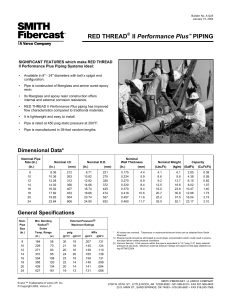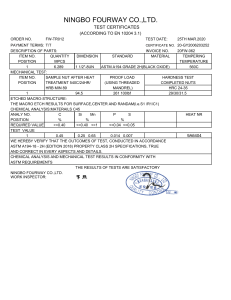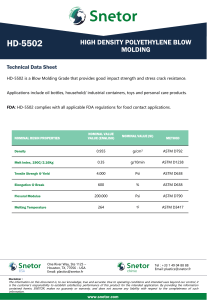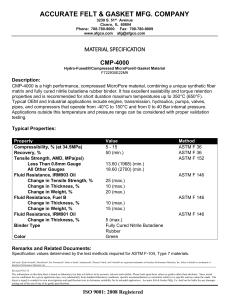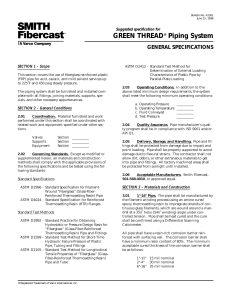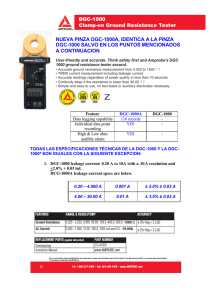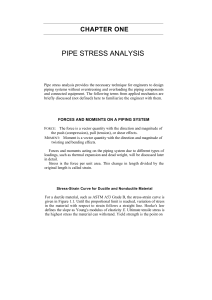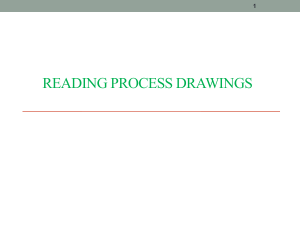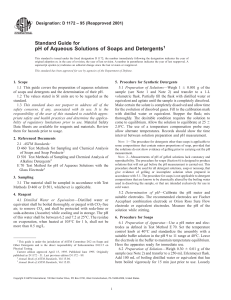field-leak-testing-of-polyethylene-pe-and-crosslinked-polyethylene-pex-pressure-piping-systems-using-hydrostatic-pressure-pdf-free
Anuncio
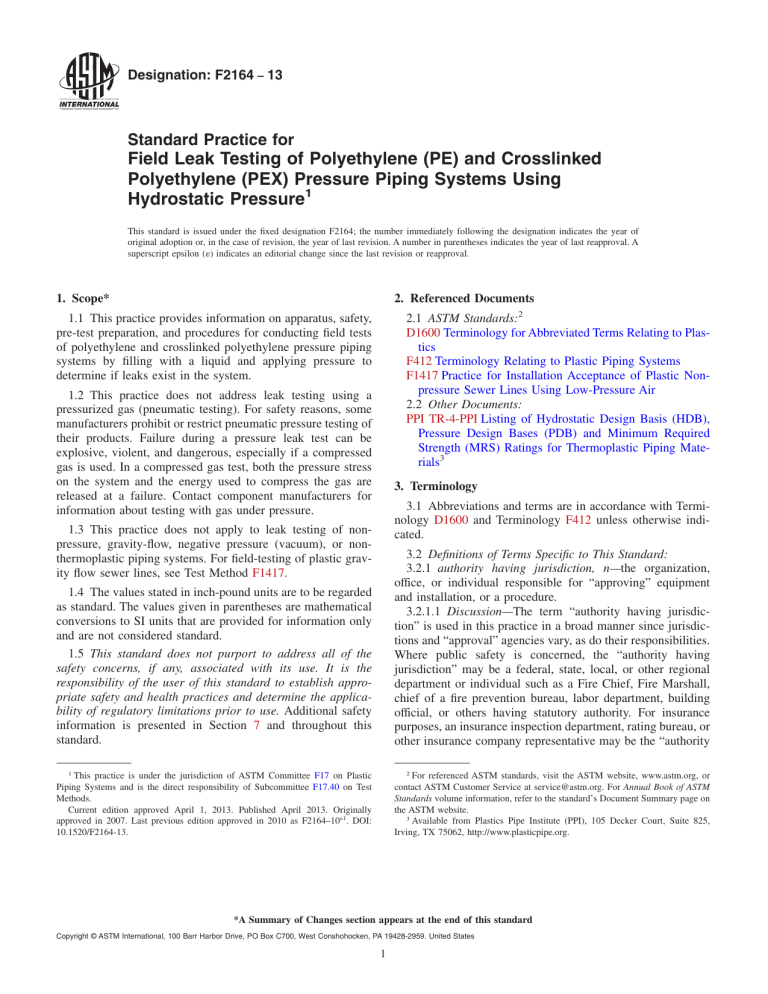
Designation: F2164 − 13 Standard Practice for Field Leak Testing of Polyethylene (PE) and Crosslinked Polyethylene (PEX) Pressure Piping Systems Using Hydrostatic Pressure1 This standard is issued under the fixed designation F2164; the number immediately following the designation indicates the year of original adoption or, in the case of revision, the year of last revision. A number in parentheses indicates the year of last reapproval. A superscript epsilon (´) indicates an editorial change since the last revision or reapproval. 2. Referenced Documents 1. Scope* 2.1 ASTM Standards:2 D1600 Terminology for Abbreviated Terms Relating to Plastics F412 Terminology Relating to Plastic Piping Systems F1417 Practice for Installation Acceptance of Plastic Nonpressure Sewer Lines Using Low-Pressure Air 2.2 Other Documents: PPI TR-4-PPI Listing of Hydrostatic Design Basis (HDB), Pressure Design Bases (PDB) and Minimum Required Strength (MRS) Ratings for Thermoplastic Piping Materials3 1.1 This practice provides information on apparatus, safety, pre-test preparation, and procedures for conducting field tests of polyethylene and crosslinked polyethylene pressure piping systems by filling with a liquid and applying pressure to determine if leaks exist in the system. 1.2 This practice does not address leak testing using a pressurized gas (pneumatic testing). For safety reasons, some manufacturers prohibit or restrict pneumatic pressure testing of their products. Failure during a pressure leak test can be explosive, violent, and dangerous, especially if a compressed gas is used. In a compressed gas test, both the pressure stress on the system and the energy used to compress the gas are released at a failure. Contact component manufacturers for information about testing with gas under pressure. 3. Terminology 3.1 Abbreviations and terms are in accordance with Terminology D1600 and Terminology F412 unless otherwise indicated. 1.3 This practice does not apply to leak testing of nonpressure, gravity-flow, negative pressure (vacuum), or nonthermoplastic piping systems. For field-testing of plastic gravity flow sewer lines, see Test Method F1417. 1.4 The values stated in inch-pound units are to be regarded as standard. The values given in parentheses are mathematical conversions to SI units that are provided for information only and are not considered standard. 1.5 This standard does not purport to address all of the safety concerns, if any, associated with its use. It is the responsibility of the user of this standard to establish appropriate safety and health practices and determine the applicability of regulatory limitations prior to use. Additional safety information is presented in Section 7 and throughout this standard. 3.2 Definitions of Terms Specific to This Standard: 3.2.1 authority having jurisdiction, n—the organization, office, or individual responsible for “approving” equipment and installation, or a procedure. 3.2.1.1 Discussion—The term “authority having jurisdiction” is used in this practice in a broad manner since jurisdictions and “approval” agencies vary, as do their responsibilities. Where public safety is concerned, the “authority having jurisdiction” may be a federal, state, local, or other regional department or individual such as a Fire Chief, Fire Marshall, chief of a fire prevention bureau, labor department, building official, or others having statutory authority. For insurance purposes, an insurance inspection department, rating bureau, or other insurance company representative may be the “authority 1 This practice is under the jurisdiction of ASTM Committee F17 on Plastic Piping Systems and is the direct responsibility of Subcommittee F17.40 on Test Methods. Current edition approved April 1, 2013. Published April 2013. Originally approved in 2007. Last previous edition approved in 2010 as F2164–10ε1. DOI: 10.1520/F2164-13. 2 For referenced ASTM standards, visit the ASTM website, www.astm.org, or contact ASTM Customer Service at [email protected]. For Annual Book of ASTM Standards volume information, refer to the standard’s Document Summary page on the ASTM website. 3 Available from Plastics Pipe Institute (PPI), 105 Decker Court, Suite 825, Irving, TX 75062, http://www.plasticpipe.org. *A Summary of Changes section appears at the end of this standard Copyright © ASTM International, 100 Barr Harbor Drive, PO Box C700, West Conshohocken, PA 19428-2959. United States 1 F2164 − 13 having jurisdiction.” In many circumstances, the property owner or his authorized engineer or agent assumes the role of the “authority having jurisdiction”; at government installations, the commanding officer or departmental official may be the “authority having jurisdiction.” 3.2.2 approved, vt—acceptable to the authority having jurisdiction. 3.2.3 pressure piping system, n—a piping system where all components in the system are pressure rated and intended for conveying a fluid under continuous internal pressure. (See also Terminology F412, pressure pipe and non-pressure pipe.) To verify suitability for pressure service, consult the component manufacturer. 5. Significance and Use 5.1 If required by the authority having jurisdiction, hydrostatic pressure leak testing may be conducted to discover and correct leaks or faults in a newly constructed or modified polyethylene or crosslinked polyethylene pressure piping system before placing the system in service. Leakage or faults usually occur at connections, joints, and mechanical seals where sealing under pressure is required. (Warning—Safety is of paramount importance when conducting hydrostatic pressure leak tests because testing under pressure may cause sudden violent rupture or failure.) 5.2 This practice uses a pressurized liquid to test for leaks. It does not verify if a piping material or a piping system design is suitable for pressure service. The suitability of a piping system for pressure service and its pressure rating or operating pressure is determined solely by its design and its installed components. NOTE 1—PPI TR-4 provides information about stress ratings for some plastic materials and products. 3.2.4 restraint, n—temporary or permanent structural measures or devices which restrict, guide, prevent, or safely limit disjoining or movement of piping system components while the system is under pressure during testing or service conditions. Restraint may include backfill, anchors, thrust blocks, external clamps and tie rods (joint restraints), pipe guides, and so forth. Restraint means that if violent separation or failure occurs during the test, any movement of components or parts is sufficiently constrained such that damage or injury is prevented. 3.2.5 system design pressure, n—the limiting continuous internal pressure specified by the piping system designer. System design pressure may be less than the pressure ratings of components in the system. System design pressure may be limited by component pressure ratings, by code or application requirements, or by other restrictions. 3.2.6 visible leakage, n—the visible escape (drip, spray, stream, flow, and so forth.) of test liquid from the test section through components, joints, connections, appurtenances, and the like in the test section. 5.3 Systems that are not suitable for pressure testing should not be pressure tested. Such systems may contain lower pressure rated or non-pressure rated components that cannot be isolated from test pressure, or temporary caps or closures may not be practical. In these systems, leak inspections should be conducted during and after installation. Inspections typically include visual examination of joint appearance, mechanical checks of bolt or joint tightness, and other relevant examinations. See also Test Method F1417. 5.4 Leakage Allowance—There is no leakage allowance for a section of heat-fusion joined polyethylene piping, because properly made heat fusion joints do not leak. See 7.6.1. 5.4.1 Other types of joints or connections in the system may have a leakage allowance. Contact the joint or connection manufacturer for information. 5.5 Expansion Allowance—When test pressure is applied, polyethylene or crosslinked polyethylene pipe will expand slightly due to elasticity and Poisson effects. To compensate for expansion, make-up water is added during the initial expansion phase. The amount of make-up water (expansion allowance) will vary because expansion is not linear. This procedure compensates for expansion with an initial expansion phase, followed by a test phase. In the test phase, expansion is suspended by slightly reducing test pressure. See 9.6. 4. Summary of Practice 4.1 The section of the piping system to be tested is isolated from other parts of the system and restrained against movement to prevent catastrophic failure. Components that are not to be subjected to test pressure or could be damaged by test pressure are isolated or removed as necessary. Isolated components are vented to atmosphere. The test section is filled with the testing liquid, raised to the test pressure, and allowed to stabilize. The system is inspected or monitored for leakage, and then test pressure is relieved. If repairs or corrections are necessary, they are performed only when the test section is depressurized. If necessary, a retest is performed after a relaxation period. At the conclusion of an acceptable test, the test section may be placed in service. Purging and disposal of the test liquid from the test section may be necessary. 5.6 Poisson Effect—When test pressure is applied to plastic piping systems that have fully restrained joints (joints such as heat fusion, electrofusion, bolted flanges, and so forth.), diametrical expansion of the pipe may reduce the overall length of the fully restrained section. Poisson-effect length reduction may affect or cause disjoining in other contiguous sections that have partially restrained or non-restrained joints, such as bell-and-spigot joints, when such joints are in-line with the test section. To prevent Poisson-effect disjoining, take measures such as the installation of external joint restraints (diametrical clamps and tie-rods) on in-line non-restrained joints, installing in-line thrust anchors at the ends of the fully restrained section, or isolating the fully restrained test section from piping with non-restrained or partially restrained joints. 4.2 Acceptance is determined by the approval of the authority having jurisdiction. 4.3 The authority having jurisdiction may specify procedures or requirements for test liquid disposal or erosion control. NOTE 2—When a tensile stress is applied to a material, it will elongate 2 F2164 − 13 regulating equipment should be capable of maintaining test pressure for the duration of the test. 6.3.1 Filling equipment and pressurizing equipment do not need to be the same equipment. in the direction of the applied stress, and will decrease in dimension at right angles to the direction of the applied stress. The ratio of decrease to elongation is the Poisson ratio. Under test pressure, piping materials will expand slightly in diameter and contract in length slightly according to the Poisson ratio of the material. 6.4 Pressure Monitoring—Use at least one calibrated pressure gage or sensor accurate to within two percent (2 %) of full scale. It is preferred that the gage or sensor full scale value not be more than twice the test pressure, and that scale graduations be no greater than two percent (2 %) of the full scale value. Using a valved tee, a gage cock for bleeding, a pressure snubber, and a duplicate, back-up pressure gage are recommended. A continuous pressure-recording device may be required. 6.4.1 Locate the test pressure gage or sensor to monitor test pressure at the lowest point in the test section. Pressure may be monitored at other points in the test section as well. 6. Apparatus and Equipment for Hydrostatic Procedures 6.1 General—Components such as caps, valves, blind flanges, manual or automatic air release devices, vents, and other devices that are used to isolate the test section from other parts of the system, to purge air from the system, and to isolate components that are not to be subjected to test pressure are generally needed. 6.1.1 Test section isolation and closure components are to be rated for pressures equal to or greater than the test pressure applied to the test section. 6.1.2 Although section isolation and closure components may only be connected to the test section for the duration of the test, the joint between the test section and a closure or isolation component should be at least as strong as joints in the test section. Additional restraint may be required. 6.1.3 Air release devices should be located at all high points along the test section. 6.1.4 Excessively worn or deteriorated equipment is unsuitable and is not to be used. NOTE 3—Test pressure is a combination of pump pressure and the height (head) of liquid in the pipeline. Therefore, test pressure is always monitored at the lowest elevation point in the section where pressure is highest. Test pressure will be lower at higher points in the section. If a minimum test pressure at higher elevations must also be met, select test sections so that the minimum test pressure is met at the higher elevation, but do not increase test pressure at the lowest point. Excessive test pressure can cause damage or pipeline failure. 6.5 Other equipment to connect the pump(s) to the test section and the test liquid supply, control the flow of test liquid, power the pump(s), connect the pressure gage(s) or sensor(s) to the test section, monitor pressure, and drain or purge the test liquid from the test section may also be necessary. 6.2 Test Liquid—An adequate supply of a safe test liquid, such as water, is necessary. The test liquid should be of appropriate safety and quality so that the environment, system, test equipment, and disposal (if necessary) are not adversely affected. 6.2.1 Where an existing water supply is used to supply test water, protect the existing water supply from backflow contamination in accordance with local codes or as required by the authority having jurisdiction. Remove backflow protection and isolate the test section from the existing water supply before testing. 6.2.2 Excluding retesting (if necessary), the quantity of liquid needed to fill the internal volume of the pipe test section and accommodate test section expansion and possible leakage at non-fusion joints and seals is estimated using: V gal 5 1.015 3 0.04 3 ~ IDin.! 2 3 L ft 7. Specific Safety Precautions 7.1 This specific safety information is in addition to the safety information in other sections of this practice. 7.2 Always take precautions to eliminate hazards to persons near lines being tested. For the entire duration of the procedure, including filling, initial pressurization, time at test pressure, and depressurization, only persons conducting the test or inspecting the system being tested should be allowed near the section under test. These persons should be fully informed of the hazards of field pressure testing. All other persons should be kept a safe distance away. (1) V m 3 5 1.015 3 0.785 3 1026 3 ~ IDmm! 2 3 L m where: Vgal IDin. Lft V m3 IDmm Lm = = = = = = 7.3 The test section is to be supervised at all times during pressure testing. pipe section volume, U.S. gal, pipe inside diameter, in., test section length, ft, pipe section volume, m3, pipe inside diameter, mm, and test section length, m. 7.4 Failure may result in sudden, violent, uncontrolled, and dangerous movement of system piping, or components, or parts of components. 7.5 Restraint Against Movement—Take measures to ensure that all parts of the section under test are restrained against movement if failure occurs. Such measures may include backfilling, anchoring, or other appropriate means. 7.5.1 Partial Backfilling During Testing—When underground connections, joints, and seals are to be exposed for observation during the test, use sufficient backfill material placed between the joints, and over the pipe to prevent movement, giving due consideration to restraining thrust forces. In particular, pipes connected to restrained joints that 6.3 Filling and Pressurizing Equipment—Liquid filling and pressurizing equipment such as pumps, and pressure regulating devices will usually be necessary. Filling equipment should be capable of filling the test section in a reasonable time against any elevation head pressure that may be present. Pressurizing equipment should be able to maintain the necessary test pressure in the test section and provide sufficient quantities of make-up test liquid for the duration of the test. Pressure 3 F2164 − 13 derive their stability from the interaction of the pipe and soil are to be backfilled prior to testing. as lower pressure-rated compression couplings or flanges with lower pressure-rated back-up rings. 7.6 Leakage usually occurs at a connection, joint, or seal in the system. Depending upon the type of connection, joint, or seal, leakage may be seepage, spray, or a stream of internal test liquid. 7.6.1 When properly made, heat fusion joints in polyethylene pipe are as strong as the pipe and do not leak. Leakage at a fusion joint indicates a faulty joint that may rupture completely at any time. If leakage is observed at a fusion joint, move away immediately, and depressurize the test section. 8.4.3 Do not use higher test pressure even though some components in the test section may have a higher pressure rating. 8.4.4 To determine the maximum test pressure at elevated temperature, apply an elevated temperature system design pressure reduction per 8.3. 8.5 Test Duration—Test duration is limited for safety reasons and to prevent damage to the system. Per 7.2 and 7.3, access to systems under test is controlled for the duration of the test. 8.5.1 When the maximum test pressure is between system design pressure and 1.5 × the system design pressure or at 1.5 × the system design pressure, total testing time including the time required to pressurize, stabilize, hold test pressure, and depressurize should not exceed 8 h. 8.5.1.1 If retesting is necessary, the test section should be depressurized for 8 h prior to retesting. 8.5.2 When the maximum test pressure is the system design pressure or less, the total test time including time required to pressurize, stabilize, hold test pressure, and depressurize should be limited to a practical time period. See 7.2 and 7.3. (A test time of about 72 h or less is suggested.) 8.5.3 Before pressure is applied, examine test equipment and all connections to and in the test section to ensure that all are in proper operating condition and tightly connected. 8.5.4 Before pressure is applied, isolated components or devices are to be vented to atmosphere. 8.5.5 Before pressure is applied, disconnect or isolate and vent all low pressure filling lines and other low pressure items. 8. Pre-Test Preparation and Set-Up 8.1 General: 8.1.1 Before testing, heat fusion joints are to be completely cooled. Mechanical joints are to be completely assembled with all necessary seals and all fasteners installed and tightened. 8.1.2 Flushing, pigging, or other means of cleaning the system to remove dirt and debris that may damage valves, regulators, and so forth, may be required before testing. 8.1.3 Allow concrete supports and anchors in the test section to cure until they have developed sufficient strength to withstand test pressure thrust forces. 8.1.4 Restrain all parts of the test section against movement in the event of failure. Temporarily remove, restrain, or isolate expansion joints and expansion compensators before starting. 8.2 Test Section—Testing may be conducted on the entire system, or on sections of the system. Test section size is determined by the capacity of the filling and pressurizing equipment. It is necessary to fill, pressurize, and test the section within the allotted overall time for the test. Equipment that has inadequate capacity may not be able to complete the test within allowable testing time limits. If so, use higher capacity test equipment, or test a smaller (shorter) section of the system. 9. Hydrostatic Test Procedure 9.1 Use appropriate apparatus per Section 6, and water or an appropriate test liquid per 6.2. 8.3 Test Temperature—Polyethylene and crosslinked polyethylene piping materials are typically pressure rated at 73°F (23°C). At higher temperatures, reduced pressure ratings and test pressures may be required. Contact pipe, fitting, or component manufacturers for assistance with elevated temperature pressure ratings. 9.2 Observe all safety precautions and specific safety precautions per Section 7. 9.3 Prepare and set-up the test section for hydrostatic pressure leak testing per Section 8. 9.4 Filling—Fill the test section slowly. Purge all air. Take all appropriate precautions to ensure that no air is trapped in the test section. (Warning—Entrapped air can result in an explosive, violent, and dangerous catastrophic failure because both the pressure stress on piping and the energy used to compress the entrapped air are released.) 9.4.1 To allow air to escape from the test section, flow velocities during filling should not exceed the capacities of air release devices or other openings used to release entrapped air. To avoid or limit transient pressure surges, the filling flow velocity should not exceed the design velocity of the piping system. 8.4 Maximum Test Pressure—Maximum test pressure is designated by the authority having jurisdiction in accordance with 8.4.1 – 8.4.4. 8.4.1 The maximum test pressure for pressure-rated polyethylene or crosslinked polyethylene piping is not to exceed 1.5 × the system design pressure where lower pressure-rated components or devices are not present, or have been removed or isolated from the test section. 8.4.2 The maximum test pressure is not to exceed the pressure rating of the lowest pressure-rated component in the test section, where lower pressure-rated components or devices cannot be removed or isolated from the test section. Consult the component manufacturer for pressure ratings. 9.5 Temperature Equalization—Allow the test section and the test liquid to equalize to a common temperature. 9.6 Pressurizing—Initial Expansion Phase—When the test section is completely filled and purged of air, gradually increase pressure in the test section to the required test pressure. NOTE 4—Lower pressure-rated components or devices may include components or devices such as pipe or fittings made from other plastics or metals, or appurtenances such as valves, hydrants, regulators, pressure relief devices, or the like, or some types of mechanical connections such 4 F2164 − 13 procedures for some post-test procedures such as test liquid draining and disposal. 9.6.1 If the test pressure cannot be attained, or if it takes an unreasonably long time to reach test pressure, there may be faults such as excessive leakage, entrapped air, or open valving, or the pressurizing equipment may be inadequate for the size of the test section. If such faults exist, discontinue pressurizing, and correct them before continuing. 9.6.2 Add make-up water as necessary to maintain maximum test pressure for 4 h. 10. Test Records 10.1 Information about the leak test may need to be recorded if required by the authority having jurisdiction. Documentation may include the following information: 10.1.1 The test liquid. 10.1.1.1 Backflow prevention devices, if used. 10.1.2 The weather conditions and ambient temperature at the site during the test. 10.1.3 The test pressure. 10.1.3.1 The type of test gages in the test section. 10.1.3.2 The placement of test gages in the test section, such as test gage location distances and elevations from the beginning of the section. 10.1.3.3 Test gage calibration records. 10.1.3.4 Test pressures recorded during the test. 10.1.3.5 Any adjustments made to test pressure for elevated temperature. 10.1.4 The test duration. 10.1.5 A description of the test section length, elevations, and site location. 10.1.6 A description of the test section components. 10.1.7 Description of any leaks or failures and the corrective actions taken. 10.1.8 The date and time of day of the test. 10.1.9 The identification of the party conducting the test. 9.7 Test Phase—Reduce test pressure by 10 psi (69.0 kPa) and monitor pressure for 1 h. Do not increase pressure or add make-up water. 9.8 Pass/Fail Criteria—If no visual leakage is observed, and pressure during the test phase remains steady (within 5 % of the test phase pressure) for the 1 h test phase period, a passing test is indicated. 9.9 Retesting—If retesting is necessary, depressurize the test section per 9.10 and correct any faults or leaks in the test section. Do not attempt to correct faults or fix leaks while the test section is under pressure. 9.9.1 When maximum test pressure is between system design pressure and 1.5 × system design pressure or at 1.5 × the system design pressure, allow the test section to “relax” for at least 8 h before re-pressurizing. After the relaxation period, repeat the initial expansion and test phases per 9.6 and 9.7. 9.10 Depressurization—Depressurize the test section by reducing pressure or releasing test liquid at a controlled rate. Sudden depressurization can cause water hammer. 9.11 After the Test—Remove temporary closure and isolation devices from the test section. Depending upon the application, flushing, disinfecting, or draining may be necessary. Regulations and codes may restrict or require specific 11. Keywords 11.1 crosslinked polyethylene; field leak test; hydrostatic leak test; leak test; polyethylene pipe SUMMARY OF CHANGES Committee F17 has identified the location of selected changes to this standard since the last issue (F2164–10ε1) that may impact the use of this standard. (5) 8.3 was revised. (6) 8.4.1 was revised. (7) Section 11 was revised. (1) Title was revised. (2) 1.1 was revised. (3) 5.1 was revised. (4) 5.5 was revised. ASTM International takes no position respecting the validity of any patent rights asserted in connection with any item mentioned in this standard. Users of this standard are expressly advised that determination of the validity of any such patent rights, and the risk of infringement of such rights, are entirely their own responsibility. This standard is subject to revision at any time by the responsible technical committee and must be reviewed every five years and if not revised, either reapproved or withdrawn. Your comments are invited either for revision of this standard or for additional standards and should be addressed to ASTM International Headquarters. Your comments will receive careful consideration at a meeting of the responsible technical committee, which you may attend. If you feel that your comments have not received a fair hearing you should make your views known to the ASTM Committee on Standards, at the address shown below. This standard is copyrighted by ASTM International, 100 Barr Harbor Drive, PO Box C700, West Conshohocken, PA 19428-2959, United States. Individual reprints (single or multiple copies) of this standard may be obtained by contacting ASTM at the above address or at 610-832-9585 (phone), 610-832-9555 (fax), or [email protected] (e-mail); or through the ASTM website (www.astm.org). Permission rights to photocopy the standard may also be secured from the Copyright Clearance Center, 222 Rosewood Drive, Danvers, MA 01923, Tel: (978) 646-2600; http://www.copyright.com/ 5

